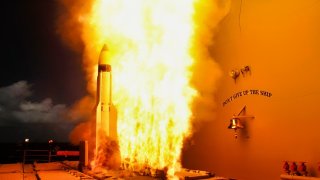SM-3 Missile Defense: The U.S. Navy Can Hit a Bullet with a Bullet
In a significant naval operation, the U.S. Navy deployed the SM-3 missile interceptor for the first time in combat to neutralize a barrage of ballistic missiles launched by Iran against Israel. The USS Carney and USS Arleigh Burke, equipped with the Aegis Ballistic Missile Defense System, utilized the SM-3 as a key defense mechanism.
Summary: In a significant naval operation, the U.S. Navy deployed the SM-3 missile interceptor for the first time in combat to neutralize a barrage of ballistic missiles launched by Iran against Israel. The USS Carney and USS Arleigh Burke, equipped with the Aegis Ballistic Missile Defense System, utilized the SM-3 as a key defense mechanism.
-The SM-3, known for its ability to destroy targets in the vacuum of space using a kinetic kill vehicle, was crucial in countering threats during this unprecedented attack, which included a mix of ballistic missiles, drones, and cruise missiles.
-This deployment not only demonstrated the missile's capabilities but also underscored its strategic importance in maintaining regional stability amidst rising tensions in the Middle East and potential future conflicts such as those in the South China Sea.
First Combat Use of SM-3 Missile Interceptor During Iranian Attack on Israel
The U.S. Navy in April deployed an SM-3 missile interceptor in combat for the first time. Missile defense, in many respects, is like hitting a bullet with another bullet. And the SM-3 achieved that goal with ease.
According to the secretary of the Navy, the USS Carney and USS Arleigh Burke fired the Standard Missile 3 to engage some of the ballistic missiles launched by Iran as part of an unprecedented strike at Israel. While the service did not at first specify which weapons it deployed to thwart the 300-odd drones and missiles Iran launched at Israel, Secretary of the Navy Carlos Del Toro’s comments to lawmakers appeared to acknowledge that the SM-3 was instrumental.
Introducing Standard Missile 3 or SM-3
The RIM-161 SM-3 is used by the Navy as part of the Aegis Ballistic Missile Defense System. The missile is designed to intercept short- and intermediate-range ballistic missiles. This ship-based surface-to-air missile uses a hit-to-kill kinetic kill vehicle to strike ballistic missiles mid-flight.
The SM-3 is the only Standard Missile type constructed to function in the vacuum of space. It is derived from the older SM-2 Block IV, which was designed as part of Aegis, an integrated weapons system that utilizes radars and computers to detect and monitor weapons when they are launched.
Specs & Capabilities
With an operational range of up to 1,550 miles, the SM-3 provides extensive defense coverage against missile threats. The basic concept of the SM-3 stems from the Strategic Defense Initiative, or SDI.
As detailed by the Center for Strategic and International Studies, the Lightweight Exo-Atmospheric Projectile Program (LEAP) is the most important component of the SDI: “Weighing a mere 13 pounds, the LEAP kill vehicle prototype employed an infrared sensor, dense electronics, and a compact set of divert thrusters. It completed its first free-flight hover test in 1991. In addition to the SM-3, LEAP’s technology was also vital to the development of the Exoatmospheric Kill Vehicle, the interceptor component of the Ground-based Interceptor.”
How Did the SM-3 Missile Perform in Combat?
The SM-3 proved its worth against Iran’s barrage. At least 120 ballistic missiles, 170 drones and 30 cruise missiles were launched from various sites across the Middle East, according to the Israel Defense Forces. While the exact types and models of ballistic and cruise missiles launched by Iran are not clear, USNI News reported that the deployment of the SM-3 indicates Tehran probably fired at least some medium-range missiles capable of reaching 1,800 miles away.
Tensions in the Middle East don’t appear to be quieting anytime soon. The U.S. is also preparing for a potential future conflict in the South China Sea. In either scenario, the SM-3 is a tremendous asset and would surely be effectively deployed again if needed.
About the Author: Maya Carlin
Maya Carlin, National Security Writer with The National Interest, is an analyst with the Center for Security Policy and a former Anna Sobol Levy Fellow at IDC Herzliya in Israel. She has by-lines in many publications, including The National Interest, Jerusalem Post, and Times of Israel. You can follow her on Twitter: @MayaCarlin.


